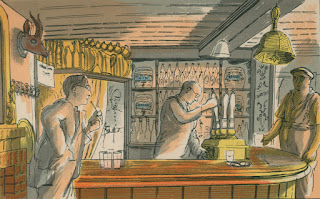Life In An English Village
Sixteen Lithographs by Edward Bawden
Introductory Essay by Noel Carrington
A King Penguin Book
Harmondsworth, Middlesex, 1949
 |
| The Vicar |
 |
| The Methodist Chapel |
 |
| The Junior School |
 |
| The Child Welfare Clinic |
 |
| Sunday Evening |
 |
| The Cabinet Maker |
 |
| The Bell |
 |
| The Butcher |
 |
| The Tailor |
 |
| The Saddler's Shop |
"All illustrations made by the artist directly onto zinc lithographic plates. They are therefore originals and not reproductions of drawings made on paper."










































